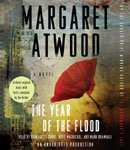
 Rivers
Rivers
By Michael Farris Smith; Read by Michael Farris Smith
Publisher: Simon & Schuster
Publication Date: September 2013
[UNABRIDGED] – 11 hours, 28 minutes
Themes: / global warming / post-apocalypse / apocalypse / survival / floods / eco-disaster /
Publisher summary:
It had been raining for weeks. Maybe months. He had forgotten the last day that it hadn’t rained, when the storms gave way to the pale blue of the Gulf sky, when the birds flew and the clouds were white and sunshine glistened across the drenched land.
Following years of catastrophic hurricanes, the Gulf Coast—stretching from the Florida panhandle to the western Louisiana border—has been brought to its knees. The region is so punished and depleted that the government has drawn a new boundary ninety miles north of the coastline. Life below the Line offers no services, no electricity, and no resources, and those who stay behind live by their own rules.
Cohen is one who stayed. Unable to overcome the crushing loss of his wife and unborn child who were killed during an evacuation, he returned home to Mississippi to bury them on family land. Until now he hasn’t had the strength to leave them behind, even to save himself.
But after his home is ransacked and all of his carefully accumulated supplies stolen, Cohen is finally forced from his shelter. On the road north, he encounters a colony of survivors led by a fanatical, snake-handling preacher named Aggie who has dangerous visions of repopulating the barren region.
Realizing what’s in store for the women Aggie is holding against their will, Cohen is faced with a decision: continue to the Line alone, or try to shepherd the madman’s captives across the unforgiving land with the biggest hurricane yet bearing down—and Cohen harboring a secret that may pose the greatest threat of all.
In a near-future apocalyptic Mississippi, hurricanes and flooding are so frequent (nearly constant) that the government has redrawn the southern border of the country above the disaster zone. Anyone living south of The Line has no government assistance, no security, and must fend for him or herself. This setting is one of the most realistic apocalyptic worlds I have read. I’m intentionally not using the word “post” because throughout the novel, destruction continues. People are trying to survive below The Line, but hail and winds and rains are still a bigger enemy than the sprinkling of humans trying to create lives for themselves.
Cohen is a man who holed up in grief until he goes against his instincts and gives a ride to a man and woman on the road. Various events force him to make the next moves in his life in order to survive. I was quite interested in the story in the first half and in the end, but the middle almost lost me as Cohen seems to wander more in his memories than in solving his problems.
I listened to the audiobook read by the author. I didn’t realize he was the reader until the end, and thought he must just be a voice actor I hadn’t heard before. His accent is subtle but places the listener within the region, and he sounds slightly worn, slightly tired, which fits the character completely.
Posted by Jenny Colvin



 GEORGE R. STEWART (1895-1980) Was an American novelist, toponymist, and professor of English at the University of California, Berkeley. His entire SFF output consisted of one Science Fiction novel
GEORGE R. STEWART (1895-1980) Was an American novelist, toponymist, and professor of English at the University of California, Berkeley. His entire SFF output consisted of one Science Fiction novel